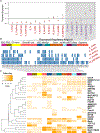Genome-wide DNA methylation profiling of primary colorectal laterally spreading tumors identifies disease-specific epimutations on common pathways
- PMID: 30183087
- PMCID: PMC6495531
- DOI: 10.1002/ijc.31765
Genome-wide DNA methylation profiling of primary colorectal laterally spreading tumors identifies disease-specific epimutations on common pathways
Abstract
Colorectal laterally spreading tumors (LSTs) grow to extremely large size while rarely invade deeply. Also, there is a low tendency to become cancerous. We used the Illumina Human Methylation 450K array to query the main epigenetic difference of LSTs. We built a discovery cohort with 10 matched cases, and a validation cohort with 9 additional matched cases. Our results suggest that LST displays significant decrease in DNA methylation, highlighted by the discovery of 1,018 hypomethylated intergenic regions (IGRs). Comparing to classic differentially methylated probes and regions that overlap transcription starting site and CpG island, IGR-regions were associated more closely with genes involved in functional biological processes and correlated with specific histone modifications. Hypomethylated IGR regions were often annotated as tissue-specific regulatory elements for noncolon tissues and were typically epigenetically silenced in normal colon mucosa. By integration of public data, we defined the commonality and specific epigenetic signatures for adenomas, LSTs and colon adenocarcinomas. Only 435 hypermethylated differentially methylated probes (DMPs) and differentially methylated regions (DMRs) and 517 hypomethylated DMPs and DMRs were shared by the three diseases. However, our pathway-level analysis discovered that genes in four pathways were common target of epimutations in LSTs, adenomas and CRCs. More interestingly, different diseases seem to employ distinct epigenetic insult to disturb specific pathways. Between LST and adenoma, we found eight pathways including Ras signaling and Rap1 signaling pathway were commonly targeted but the epimutation patterns were opposite. Comparison between precancerous conditions and invasive states revealed the key pathways governing the progression to malignancy, including PI3K-Akt pathways.
Keywords: DNA methylation; DNA methylation array; epimutation; laterally spreading tumors.
© 2018 UICC.
Conflict of interest statement
Figures






Similar articles
-
Integrated Genetic, Epigenetic, and Transcriptional Profiling Identifies Molecular Pathways in the Development of Laterally Spreading Tumors.Mol Cancer Res. 2016 Dec;14(12):1217-1228. doi: 10.1158/1541-7786.MCR-16-0175. Epub 2016 Sep 26. Mol Cancer Res. 2016. PMID: 27671336
-
Differences in DNA methylation signatures reveal multiple pathways of progression from adenoma to colorectal cancer.Gastroenterology. 2014 Aug;147(2):418-29.e8. doi: 10.1053/j.gastro.2014.04.039. Epub 2014 Apr 30. Gastroenterology. 2014. PMID: 24793120 Free PMC article.
-
Analysis of molecular alterations in laterally spreading tumors of the colorectum.J Gastroenterol. 2017 Jun;52(6):715-723. doi: 10.1007/s00535-016-1269-y. Epub 2016 Oct 4. J Gastroenterol. 2017. PMID: 27704264
-
Methylation epigenotypes and genetic features in colorectal laterally spreading tumors.Int J Cancer. 2014 Oct 1;135(7):1586-95. doi: 10.1002/ijc.28814. Epub 2014 Mar 10. Int J Cancer. 2014. PMID: 24590867
-
Integrated Analysis of the Endoscopic, Pathological and Molecular Characteristics of Colorectal Tumorigenesis.Digestion. 2019;99(1):33-38. doi: 10.1159/000494410. Epub 2018 Dec 14. Digestion. 2019. PMID: 30554192 Review.
Cited by
-
Multi-omics analysis reveals novel causal pathways in psoriasis pathogenesis.J Transl Med. 2025 Jan 22;23(1):100. doi: 10.1186/s12967-025-06099-w. J Transl Med. 2025. PMID: 39844246 Free PMC article.
-
Genome-wide methylation profiling of early colorectal cancer using an Illumina Infinium Methylation EPIC BeadChip.World J Gastrointest Oncol. 2022 Apr 15;14(4):935-946. doi: 10.4251/wjgo.v14.i4.935. World J Gastrointest Oncol. 2022. PMID: 35582104 Free PMC article. Clinical Trial.
-
Identification of genetically predicted DNA methylation markers associated with non-small cell lung cancer risk among 34,964 cases and 448,579 controls.Cancer. 2024 Mar 15;130(6):913-926. doi: 10.1002/cncr.35130. Epub 2023 Dec 6. Cancer. 2024. PMID: 38055287 Free PMC article.
-
Genome-wide analysis of the hypoxia-related DNA methylation-driven genes in lung adenocarcinoma progression.Biosci Rep. 2020 Feb 28;40(2):BSR20194200. doi: 10.1042/BSR20194200. Biosci Rep. 2020. PMID: 32031203 Free PMC article.
-
Birthweight DNA methylation signatures in infant saliva.Clin Epigenetics. 2021 Mar 19;13(1):57. doi: 10.1186/s13148-021-01053-1. Clin Epigenetics. 2021. PMID: 33741061 Free PMC article.
References
-
- Kudo S, Kashida H, Nakajima T, Tamura S, Nakajo K. Endoscopic diagnosis and treatment of early colorectal cancer. World J Surg 1997;21: 694–701. - PubMed
-
- Kudo S Endoscopic mucosal resection of flat and depressed types of early colorectal cancer. Endoscopy 1993;25: 455–61. - PubMed
-
- Takahashi T, Nosho K, Yamamoto H, Mikami M, Taniguchi H, Miyamoto N, Adachi Y, Itoh F, Imai K, Shinomura Y. Flat-type colorectal advanced adenomas (laterally spreading tumors) have different genetic and epigenetic alterations from protruded-type advanced adenomas. Mod Pathol 2007;20: 139–47. - PubMed
-
- Kaku E, Oda Y, Murakami Y, Goto H, Tanaka T, Hasuda K, Yasunaga M, Ito K, Sakurai K, Fujimori T, Hattori M, Sasaki Y. Proportion of flat- and depressed-type and laterally spreading tumor among advanced colorectal neoplasia. Clin Gastroenterol Hepatol 2011;9: 503–8. - PubMed
-
- The Paris endoscopic classification of superficial neoplastic lesions: esophagus, stomach, and colon: November 30 to December 1, 2002. Gastrointestinal endoscopy 2003;58: S3–43. - PubMed
Publication types
MeSH terms
Grants and funding
LinkOut - more resources
Full Text Sources
Other Literature Sources
Medical

